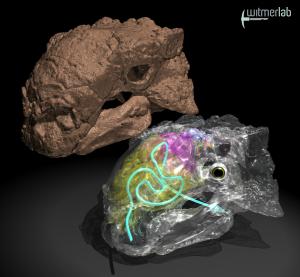 |
| A Euoplocephalus skull (top left) and a model of the scans (bottom right). The green tube is the nasal passage |
It was well known that the ankylosaurids had small brains. Some could fit into a coffee mug, others were not much bigger than this. Yet the inside of the skull remained a mystery. The dense armour meant that scans were not reliable; and no curator would allow palaeontologists to crack open a skull, take casts and perform more sophisticated scans. Now palaeontologists have discovered an ankylosaurid skull, not in the badlands of Nevada or the like, but in the storage rooms of the University of Alberta.
Lead researcher Tetsuto Miyashita found a 72 million year old Euoplocephalus cranium. It was damaged, allowing Miyashita a unique view of the nasal passages, blood vessels and brain case. While it again showed that these creatures had very small brains in relation to body size, there was another feature that was far more surprising. Its nasal passage was not a relatively straight and short airway, but was made up instead of loops, twists and turns inside the armoured head. A 2008 study led by Dr Ryan Ridgely of the American Natural History Museum showed similar results.
The question is why. The various research teams believe that it used its extraordinary nasal passages to generate low frequency sounds to communicate with other members of its species. A study of its ear shows that it was built to register such frequencies. Its brain size shows that, as well as a good sense of smell, it had also had very well developed auditory capacities. Euoplocephalus is very similar to many of ankylosaurids, so the results of this study can be re-applied, giving us a greater insight into the lives of this animal group.